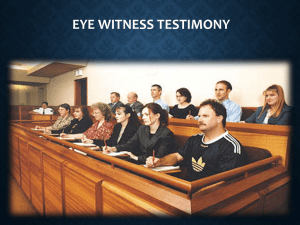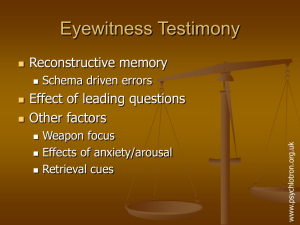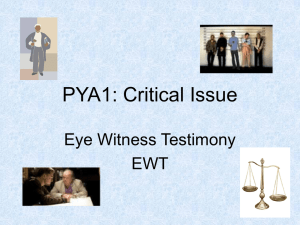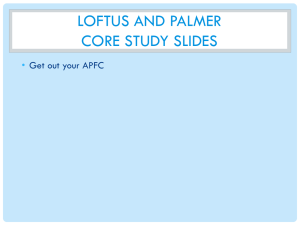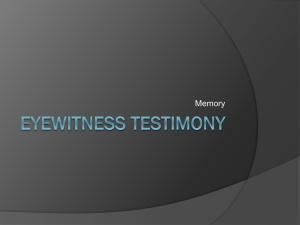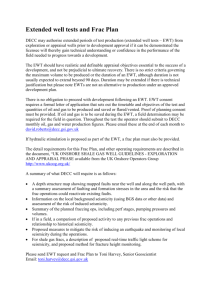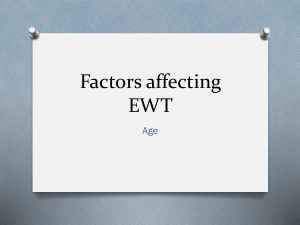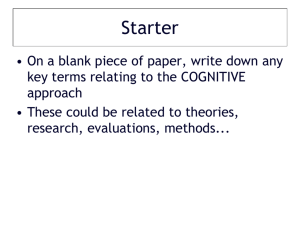Reliability of memory introduction
advertisement
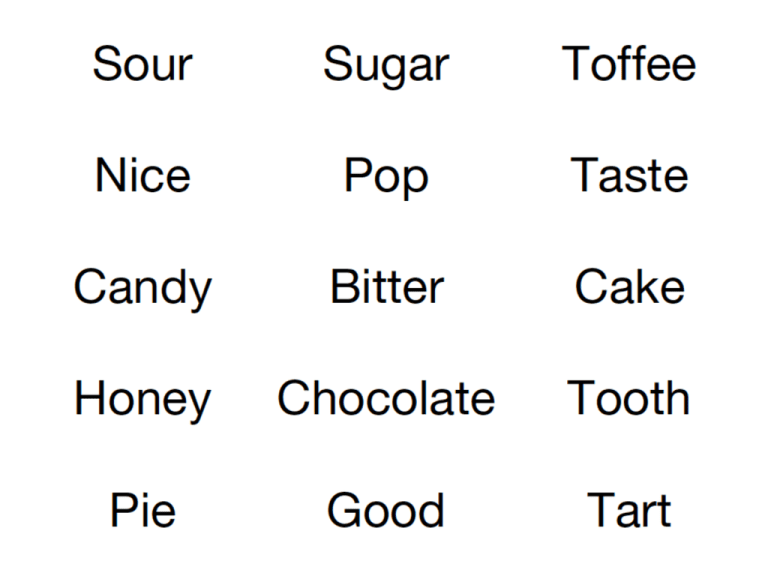
Write them down Write them down Did you note down ‘sweet’ and ‘angry’? Learning outcome • With reference to relevant research studies, to what extent is one cognitive process reliable? • Our cognitive process will be Memoryspecifically reconstructive memory. Reconstructive memory • Schemas – Knowledge structures that relate to commonly encountered objects, situations or people – Enable us to predict events, make sense of unfamiliar circumstances, organise our own behaviour – Act as filters to perception & recall Computer Information Processing BANG! www.psychlotron.org.uk Can you wreck a nice beach? Schema Driven Processing Yes. I can recognise speech. www.psychlotron.org.uk Can you wreck a nice beach? Bartlett (1932) Input Schema Output ‘Turf cutter’ Bartlett (1932) www.psychlotron.org.uk ‘Pickaxe’ Bartlett (1932) • War of the Ghosts – Shorter – Less detailed – Some details changed (e.g. seal hunting changed to fishing) – More ‘Western’ structure www.psychlotron.org.uk • When recalled by UK ppt’s: Allport and Postman (1947) • Showed ppt’s a picture of a black man and a white man in an argument. • White ppt’s incorrectly remembered the black man as the the one who was holding the cutthroat razor. Reasons for inaccuracies in memory • Reason 1 • Memories are reconstructive (Bartlett 1932 and Allport and Postman 1947) because information processing is schema driven. Why does this matter? • The reliability of memory has interested psychologists due to its repercussions within the legal system. • Court cases are especially dependent on the reliability of eyewitness testimony (EWT) Eye-witness testimony (EWT) • Eye witness testimony is evidence supplied by people who witness a specific event or crime, relying only on their memory. • Statements often include descriptions of the criminal (facial appearance and other identifiable characteristics) • Subsequent identification • Details of the crime scene (eg the sequence of events, time of day, and if others witnessed the event etc). How accurate is eyewitness testimony? • In 1984, American college student Jennifer Thompson was raped at knifepoint by a man who burst into her flat. • During the ordeal she concentrated on every detail of her attacker so that she could later accurately recall him. • Later that day she worked with police to compose a sketch of her assailant. • A few days later she identified Ronald Cotton as the rapist and picked him out of an identity parade. • On the strength of her EWT Ronald Cotton was imprisoned. Jennifer was so sure of his guilt and wanted him electrocuted. • In 1995, after serving 11 years in prison, DNA evidence proved that Ronald Cotton was innocent and he was released. How accurate is eyewitness testimony? • In the USA, in more than 100 convictions in which people have later been shown to be innocent by DNA testing, 75% of them were convicted on the evidence of an eyewitness. • There is the serious prospect that innocent people have been executed in the USA on the basis of EWT. EWT: Schema Driven Errors • Witnesses to crimes filter information during acquisition & recall – Distortions may occur without the witness realising www.psychlotron.org.uk – Their schematic understanding may influence how info is both stored & retrieved EWT: Schema Driven Errors • Past experiences • Stereotypes & beliefs about crime & criminals www.psychlotron.org.uk • Assumptions about what usually happens Anxiety/Shock Age Leading questions Individual differences Consequences Time delay Factors that affect EWT Leading questions: This is a question that contains hints about what the right/desired answer should be. • Key study: Loftus and Palmer 1974 Aims • Loftus and Palmer’s experiment was actually two experiments. • They wanted to investigate in general how accurate or inaccurate memory was. Specifically they wanted to see the effect of leading questions upon estimates of speed. Aims • Experiment 1 – See if the speed estimates would be influenced by the wording of the question asked. – Hit vs Smashed Aims • Experiment 2 – To see if the leading questions just changed the responses given to the questions, or whether the participant’s memories had actually altered as a result of the leading questions. Procedures • Type of study: Laboratory experiments • See hand out of Loftus and Palmer 1974 Task • Find a clip of an incident (download so it can be played). • Formulate four questions about the event, one of these must be a leading question. Other factors that affect EWT Interested in Loftus? • Find out more: http://faculty.washington.edu/eloftus/ Practical applications • In the UK, the Devlin Report (1976) recommended that that no jury should convict on the evidence of a single eyewitness testimony alone. Barristers are also not allowed to aske leading questions for fear of generating false testimonies. • In the USA (1990’s) the “Innocence project” has helped to overturn the wrongful convictions through faulty EWT of 220 men (by 2008).

